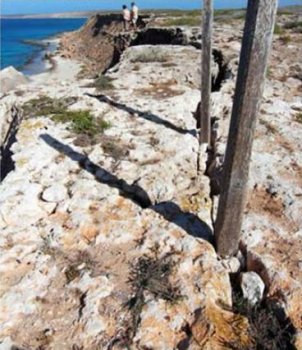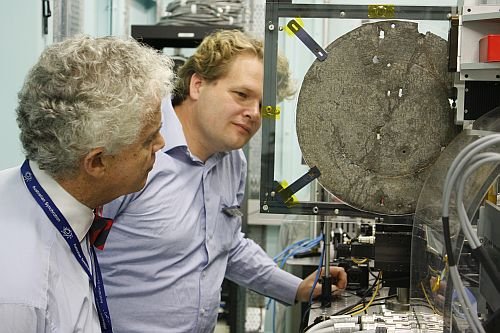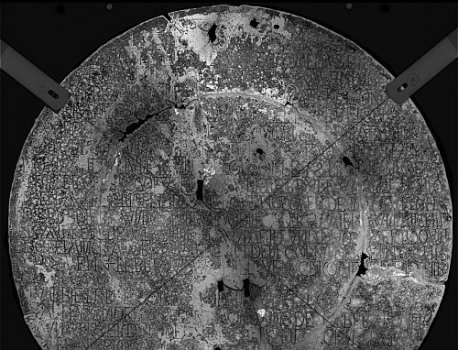28 June 2013
An historic metal plate that is one of Australia’s oldest records of European contact has been analysed at the Australian Synchrotron.


In May 2013, the 35-centimetre pewter ‘de Vlamingh plate’ was removed from its argon-filled, bullet-proof display case in Fremantle, WA, strapped into its own personal economy-class airline seat, and brought to the Synchrotron for x-ray analysis. West Australian and Victorian experts in the preservation of historic metal artefacts say the x-ray analysis is essential to ensure that the 35-centimetre plate can be preserved for future generations.
The de Vlamingh plate, images courtesy of WA Museum
The story of a plate
The plate’s story begins in 1697 when Dutch explorer Willem de Vlamingh and the crew of the Geelvinck nailed it to a wooden post on a remote and West Australian island some 830 kilometres north of Perth: Dirk Hartog Island in Shark Bay. As was common practice amongst early Dutch explorers, they engraved the plate to mark their visit, recording the name of the explorers, their vessel and the date of their voyage. They also engraved details of their discovery of a similar plate engraved and left in the same place in 1616 by Dutch explorer Dirk Hartog and the crew of the Eendracht. De Vlamingh took the earlier plate with him to the Dutch East Indies, and the Hartog plate is now housed in the Rijksmuseum in Amsterdam.
The de Vlamingh plate survived 121 years on windswept Cape Inscription at the northern end of Dirk Hartog Island before being taken by French explorer Louis de Freycinet for safekeeping. Freycinet and the plate eventually made it back to France after being shipwrecked in the Falklands. The plate then spent a century or more lying forgotten on a storeroom shelf until it was rediscovered after the WWII German occupation of Paris. The plate was returned to Australia as a goodwill gesture in 1947, and placed into secure storage at the West Australian Museum in the early 1950s.
Photo at right: Dirk Hartog Island, image courtesy of WA Museum
For the last two decades, the de Vlamingh plate has been on display at the Western Australian Museum inside a bullet-proof container filled with inert argon gas to guard against further deterioration of the pitted and cracked surface.
In preparation for the 400th anniversary of Dirk Hartog’s visit in 1616, WA Museum conservation expert Dr Ian MacLeod has joined forces with metals conservator David Thurrowgood from the National Gallery of Victoria (NGV). The pair brought the plate to the Synchrotron in May 2013 to use state-of-the-art x-ray fluorescence microscopy (XFM).
Synchrotron provides a roadmap
The aim is to determine the precise elemental distribution and makeup of the plate, examine surface corrosion and salt contamination, and take a close look at some areas of previous restoration work.

Photo L-R: Ian MacLeod (WA Museum) and David Thurrowgood (NGV) inspect the de Vlamingh plate on the XFM beamline
“Although the de Vlamingh plate has been on public display for almost 20 years, we didn’t have any records of its treatment or the results of any previous scientific analysis,” says Ian MacLeod. “We didn’t know what the plate was made from, or the extent of its deterioration, or how much salt was present in the cracks.”

The synchrotron scans revealed the plate comprised around 85 per cent tin, typical of pewter from that period, with a halo of copper, zinc and arsenic around the holes made by 17th century square-shanked bronze sheathing nails.
Photo below: Map of de Vlamingh plate showing spatially resolved x-ray fluorescence tin signal, with measurements taken at 100 micron steps across the surface giving an accurate depiction of the plate’s surface. The darker areas show where tin has been lost by localised corrosion, or has been covered up by contaminants or corrosion products. The ‘cross hairs’ are lengths of nylon fishing line tensioned on spring steel flats (top corners of image) screwed into a perspex supporting frame to ensure that the plate could not fall out of the frame during the scanning process. The nylon has absorbed some of the x-rays. Image: Daryl Howard (AS).
“We now have unprecedented chemical information about the object’s surface and the corrosion processes leading to deterioration,” David says. “The scan has also enabled new discoveries about the origins and history of the plate to be deduced from localised elemental distribution features.”
“The synchrotron analysis has given us a ‘roadmap to conservation’,” Ian says, “So now decisions about stabilising, storing and transporting the plate can be made on the basis of scientific information rather than ignorance.”
Ian plans to travel to Amsterdam later this year to begin negotiating with the Rijksmuseum for the potential loan of the Hartog plate in 2016. If he succeeds, the Hartog plate would go on display in WA for the 400th anniversary of Dirk Hartog’s visit in 1616 – reuniting the plates for the first time in almost 320 years. The de Vlamingh plate would travel to Amsterdam in a reciprocal arrangement.
Gallery work
For the past five years, David Thurrowgood and NGV colleagues have been working with CSIRO and AS scientists to apply the capabilities of the Australian Synchrotron to cultural heritage preservation and study. The collaborators have previously conducted an in-depth study of a self-portrait of Arthur Streeton subsequently painted over by the artist. They are continuing to refine their methods and apply these to other valuable paintings and to cultural and heritage materials more broadly. Knowing which elements are present and where in paintings, for example, provides valuable information on pigment usage, assisting scholars, curators and restorers and in some cases potentially also helping to answer questions of provenance and authenticity. David is applying his expertise to the study and preservation of the de Vlamingh plate, and the results will influence how the gallery stores and displays its valuable collection of ancient metals to enable greater public access to these significant historical artefacts.
